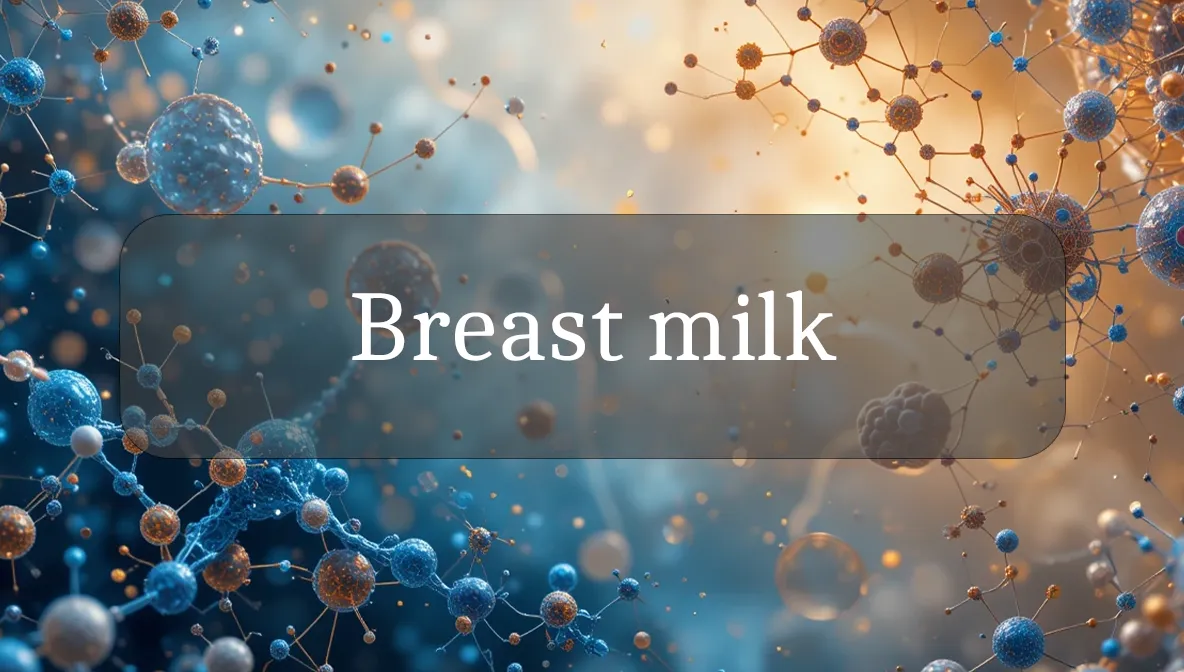Nature’s Perfect Food for Babies
Breast milk is often called “liquid gold” for its incredible ability to nourish and protect newborns. This remarkable body fluid is uniquely designed to support a baby’s growth, immunity, and overall health. Let’s explore what makes breast milk so special, its benefits for both baby and mother, and how to support its production for optimal wellness.
Identity and Function
Breast milk is a complex, living fluid produced by the mammary glands of lactating women. It’s a dynamic mix of water, proteins, fats, carbohydrates, vitamins, minerals, enzymes, and immune factors tailored to meet a baby’s changing needs. Its primary functions include:
- Nutrition: Provides all the essential nutrients a baby needs for growth and development in the first six months.
- Immune Protection: Delivers antibodies and immune cells to fight infections.
- Digestive Support: Contains enzymes to aid a baby’s developing digestive system.
- Developmental Benefits: Supports brain, gut, and organ development with bioactive compounds.
Health Benefits and Physiological Role
Breast milk is a powerhouse for both baby and mother, offering benefits that extend beyond basic nutrition:
- For Babies:
- Optimal Nutrition: Supplies the perfect balance of proteins, fats, and sugars (like lactose) for growth and energy.
- Immune Boost: Antibodies (like IgA) and immune cells protect against infections, reducing risks of ear infections, diarrhea, and respiratory illnesses.
- Brain Development: Omega-3 fatty acids (like DHA) support cognitive and visual development.
- Gut Health: Promotes a healthy gut microbiome, reducing the risk of allergies and digestive issues.
- For Mothers:
- Faster Recovery: Breastfeeding triggers oxytocin release, helping the uterus shrink post-delivery and reducing bleeding.
- Long-Term Health: Lowers risks of breast and ovarian cancer, type 2 diabetes, and postpartum depression.
- Bonding: Fosters emotional connection through skin-to-skin contact. Breast milk supports a baby’s health from day one and offers lifelong benefits for both mother and child.
Production and Sources
Breast milk is produced naturally by the body during and after pregnancy:
- How It’s Made: Hormones like prolactin and oxytocin, triggered by pregnancy and infant suckling, stimulate milk production in the mammary glands. Colostrum (the first milk) transitions to mature milk within days.
- Stages:
- Colostrum (days 1–5): Thick, yellowish, and rich in antibodies.
- Transitional Milk (days 5–14): Higher in fat and calories as supply increases.
- Mature Milk (after 2 weeks): A balanced mix of foremilk (thinner, hydrating) and hindmilk (richer, calorie-dense).
- Influencing Factors: Frequent breastfeeding or pumping, maternal hydration, nutrition, and stress levels impact supply. The baby’s demand drives production—more suckling means more milk.
Signs of Imbalance
Issues with breast milk production or composition are uncommon but can occur:
- Low Milk Supply:
- Signs: Baby not gaining weight, fewer wet diapers (less than 6–8 daily), or fussiness after feeding.
- Causes: Stress, dehydration, infrequent feeding, or medical conditions like thyroid issues.
- Oversupply:
- Signs: Baby choking or spitting up during feeds, frequent leaking, or breast engorgement.
- Causes: Overstimulation from pumping or hormonal factors.
- Composition Issues: Poor maternal nutrition (e.g., low fat or vitamin intake) may affect milk quality, though the body prioritizes the baby’s needs.
- Infections: Mastitis (breast infection) can cause pain, fever, or changes in milk appearance (e.g., pus or blood). Seek medical help if noticed. If you suspect supply issues or infection, consult a lactation consultant or doctor.
Supporting Healthy Function
You can optimize breast milk production and quality with practical steps:
- Breastfeed or Pump Frequently: Nurse or pump every 2–3 hours to stimulate supply, especially in the first weeks.
- Stay Hydrated: Drink water throughout the day (aim for 8–12 cups) to support fluid needs.
- Eat Nutrient-Dense Foods: Focus on whole grains, lean proteins, healthy fats (like avocados, nuts), and fruits/vegetables for vitamins like A, D, and C.
- Rest and Reduce Stress: Get adequate sleep (nap when baby naps) and try relaxation techniques like deep breathing to support hormone balance.
- Seek Support: Work with a lactation consultant for latch issues, low supply, or pain during breastfeeding.
- Avoid Toxins: Limit alcohol, caffeine, and avoid smoking, as these can pass into milk and affect the baby.
Safety and Precautions
Breast milk is naturally safe, but a few precautions ensure it remains beneficial:
- Maternal Health: Conditions like HIV or certain medications (e.g., chemotherapy drugs) may make breastfeeding unsafe. Consult your doctor if you have concerns.
- Storage Safety: Store pumped milk properly (refrigerator: up to 4 days; freezer: up to 6 months) to prevent bacterial growth. Use clean containers and follow guidelines.
- Medications and Substances: Some drugs, alcohol, or herbs (like peppermint) can affect milk supply or baby’s health. Check with a healthcare provider before use.
- Infections: If you have mastitis or nipple infections, seek treatment promptly to avoid complications. Always discuss breastfeeding concerns with a healthcare provider or lactation expert.
Fun Fact
Breast milk adapts to your baby’s needs! Its composition changes during a single feed (from watery foremilk to richer hindmilk), over the day, and even as your baby grows, tailoring nutrients and antibodies to their specific stage of development.
Citations
- National Institutes of Health (NIH): Breastfeeding and Breast Milk Benefits.
- Mayo Clinic: Breastfeeding Nutrition and Health.
- Cleveland Clinic: Breast Milk Production and Lactation.
- World Health Organization (WHO): Breastfeeding Guidelines.
- American Academy of Pediatrics (AAP): Breastfeeding and Infant Nutrition.

